As we con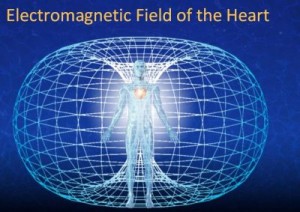 tinue to rest in stillness, while the universe flows through us, in the on going stream of karma and creativity, we somatic explorers can also use the yoga postures to help with the flossing the chakras, creating a more clear channel for the light. Always cycling through the heart, the energies of the asanas can be very helpful in both differentiating and integrating the various modes of energy associated with each of the seven main chakras, allowing our creativity to unfold and flower at more and more interesting levels.
tinue to rest in stillness, while the universe flows through us, in the on going stream of karma and creativity, we somatic explorers can also use the yoga postures to help with the flossing the chakras, creating a more clear channel for the light. Always cycling through the heart, the energies of the asanas can be very helpful in both differentiating and integrating the various modes of energy associated with each of the seven main chakras, allowing our creativity to unfold and flower at more and more interesting levels.
For most modern humans with a confused upright posture, the bottom two chakras are squashed together with almost no differentiation. We will use our supported bridge pose to begin the process of opening space between them and developing a sense of fluid differentiated movement. Then we will integrate this opening and new sense of space into our play in the rest of the standing poses, and then all the rest of the poses in your repertoire. The water element makes for very juicy yoga!
Structurally, the pelvic bones are the first and most obvious link, as they connect with the femurs to form the hip joints, powerful 1st chakra centers, and also with the sacrum at the sacro-illiac joints to motivate the 2nd chakra. As you can see above, there are numerous nerves, ligaments and muscle fibers here, so this is very dynamic space. There is another hidden link, the elusive joint between the sacrum and the coccyx, much more obvious in animals with a larger tail. For most, the L5 – S1 joint, where the sacrum connects to the lower lumbar, is hypermobile, leading to excess movement and injury here. If you can ‘stabilze L5 – S1, and mobilize the sacral-coccyx joint, you will have very different spianl experience! Your imaginary tail will make this link more accessible, and this will help open up the center channel with what we will call a bit later ‘lateral space’.
One observation we can make, before we go further, is that chakra 1 represents the element earth and stability, while chakra 2 represents the element water and mobility. As students of asana, sthira sukham asanam comes immediately to mind. If we can find the dynamic balance of stability and mobility through the structures and energy fields of the two lower chakras, we have the perfect foundation for all subsequent movement needs. Eric Franklin’s 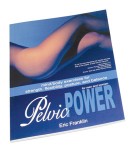 very helpful book, “Pelvic Power” is full of great imagery, exercises and education. I love the fountain!
very helpful book, “Pelvic Power” is full of great imagery, exercises and education. I love the fountain!
A second observation is that one can be very integrated in structure and movement down there and still be emotionally dysfunctional. There is no shortage of highly skilled professional athletes who fit this profile. The element water is also associated with emotions, and the second chakra is also the center of sexual energy, so as we begin to release the bound energy of the second chakra, we need the grounding energy of the first chakra to stabilize us, and the wisdom of the heart chakra to make sure our actions are always expressions of the heart.
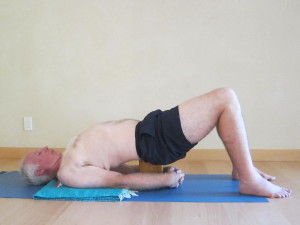 Place the block directly under the sacrum. I prefer a wooden block, as the feedback is clear and the block is stable. I find the foam blocks less stable unless you stack them, and then you lose the precision of the narrow edge. However, your body has to be safe and comfortable.
Place the block directly under the sacrum. I prefer a wooden block, as the feedback is clear and the block is stable. I find the foam blocks less stable unless you stack them, and then you lose the precision of the narrow edge. However, your body has to be safe and comfortable.
Feet are alive, continuing to ground the energy, even though the primary grounding is now through the block. Gently press the feet forward to create a rebound energy coming back towards your head. Channel it through the center of the pelvis. To do this, the pelvis is neither tucked, nor untucked, but floating in neutral, parallel to the floor. This pose is not about how much height you can create up to the ceiling, but about how accurately the energy flows through the core. The block gives you feed back for exactly where the sacrum is. As you press the feet, feel that action is coming from the pelvic bones reaching toward the knees, right and left evenly. This would be grounding if you were standing. Let the rebound move in the opposite direction through the sacrum so you feel the double action centered right where the hips and sacro-illiacs are located. Allow a space to emerge between the bones, without a sense of ‘stretching’ anything. Just energy flow, ground and space. Feel the diaphragm and heart expanding to receive the pelvic energy. Feel the fountain.
Now begin to grow a tail that extends out past the knees. Try a mammal tail and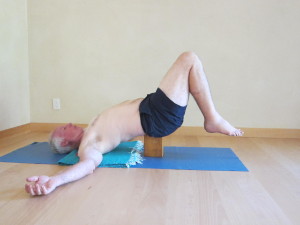 oscillate between flexion and extension, forward and back bending actions, just with the tail, but let the fluids of the whole body respond. The other spinal vertebrae may also move in a wave like motion. Let them feel the fluid motion, but try to not help by contracting any muscles. This is the beginning of differentiating the front and back body from the center and opening up the inner ‘volume’ of the body. Inhabiting this inner space is key in the somatic awakening process.
oscillate between flexion and extension, forward and back bending actions, just with the tail, but let the fluids of the whole body respond. The other spinal vertebrae may also move in a wave like motion. Let them feel the fluid motion, but try to not help by contracting any muscles. This is the beginning of differentiating the front and back body from the center and opening up the inner ‘volume’ of the body. Inhabiting this inner space is key in the somatic awakening process.
Then take the feet up without losing the tail so there is no ‘gripping in the lumbar sacral area. There will be some engagement of the deeper muscles as they align with the flow. Experiment with slowly moving up and down to involve different regions of the spine as the legs and sacrum adapt to the changing angles, and then land gently without losing the awareness.
Next, try a fish tail with side to side wave motion. Big fish! Let the whole ‘chakra line’ feel fluid, let all the vertebrae have a chance to feel the integrated flow. The fish tail action is the beginning of finding the lateral space that opens up through the second chakra as the two pelvic bones differentiate. That the right and left feet and legs can move independently is obvious. When the two pelvic bones can differentiate, at the pubic bones and at the sacro-illiacs, the second chakra can begin to breathe and the side to side or lateral differentiation and volume awakens.
 With one leg extending upward you can explore this new awareness. Let the pelvic bones follow the legs, leaving the sacrum floating above the block. This can help release tension in the deep spinal muscles along the length of the spine. The other leg remains in hip extension and you can begin to sense space in the center plane of the torso with the help of the tail. The legs stay alive as the fluidity supports the expanding of diaphragm, intercostals, mesentery and mediastinum. The pelvic bones and spine are often ‘confused’, meaning they are stuck together perceptually. So as the fish body awakens, the spine becomes more and more free to feel like a fish because the legs, from pelvis to feet, float away. This is more obvious in the next stage.
With one leg extending upward you can explore this new awareness. Let the pelvic bones follow the legs, leaving the sacrum floating above the block. This can help release tension in the deep spinal muscles along the length of the spine. The other leg remains in hip extension and you can begin to sense space in the center plane of the torso with the help of the tail. The legs stay alive as the fluidity supports the expanding of diaphragm, intercostals, mesentery and mediastinum. The pelvic bones and spine are often ‘confused’, meaning they are stuck together perceptually. So as the fish body awakens, the spine becomes more and more free to feel like a fish because the legs, from pelvis to feet, float away. This is more obvious in the next stage.
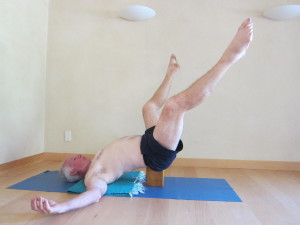 It all comes down to water, collagen, physics and sacred geometry: Now, with legs and pelvis free of the spine, play in this ‘Continuum’ exploration of the inner world that is opening. The balance of water (compression) and collagen (tension) build the tensegrity field, where every fiber feels connected fluidly and elastically to every other fiber, whether muscle, bone, organ, cell or fascia. Let the body take on any shape it desires. If the arms want o float upwards, let them go with it. Drop habits and holding and be as free as an anemone. There is a spectrum of of learning and freedom of expression, of course. It builds over time as Hebb’s Axion deepens the integration. When you are ready to carry this into other poses, retain the inner balance of fluidity and stability. Stay grounded and sing and dance your heart away!
It all comes down to water, collagen, physics and sacred geometry: Now, with legs and pelvis free of the spine, play in this ‘Continuum’ exploration of the inner world that is opening. The balance of water (compression) and collagen (tension) build the tensegrity field, where every fiber feels connected fluidly and elastically to every other fiber, whether muscle, bone, organ, cell or fascia. Let the body take on any shape it desires. If the arms want o float upwards, let them go with it. Drop habits and holding and be as free as an anemone. There is a spectrum of of learning and freedom of expression, of course. It builds over time as Hebb’s Axion deepens the integration. When you are ready to carry this into other poses, retain the inner balance of fluidity and stability. Stay grounded and sing and dance your heart away!

